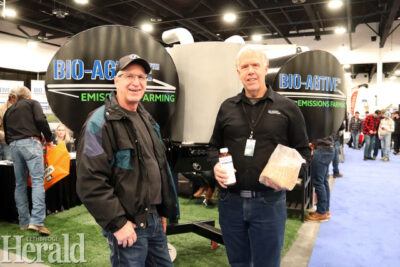Farmer uses machinery emissions to help crops grow
By Alejandra Pulido-Guzman - Lethbridge Herald on February 29, 2024.
 Herald photo by Alejandra Pulido-Guzman
Gary Lewis with Bio-Agtive emissions farming, at right, displays some of the grain produced using his invention, alongside Dale Wenzel, a producer from Leader, SK. who uses Bio-Agtive, during Ag-Expo on Wednesday at the Agri-Food Hub and Trade Centre.
Herald photo by Alejandra Pulido-Guzman
Gary Lewis with Bio-Agtive emissions farming, at right, displays some of the grain produced using his invention, alongside Dale Wenzel, a producer from Leader, SK. who uses Bio-Agtive, during Ag-Expo on Wednesday at the Agri-Food Hub and Trade Centre.LETHBRIDGE HERALDapulido@lethbridgeherald.com
A southern Alberta farmer has found a way to use his machinery’s emissions to help his crops grow instead of using fertilizer and took the opportunity to share his invention with others at Ag-Expo.
Gary Lewis with Bio-Agtive Emissions Farming spoke to the Herald Wednesday about his invention. He has been studying plant physiology for the last 24 years and been experimenting and perfecting his technique.
“Twenty-four years ago, I started to look at my farm wondering where I can get energy for free because agriculture uses about 20 calories of energy to grow one calorie of food,” said Lewis.
He said because of his motor mechanic background, the internal combustion engine became his focus.
“What we’re doing here is we’re taking the emissions from internal combustion and we’re repurposing it. It used to be a plant – if it was a diesel fuel, or if it’s biodiesel or if it’s vegetable oil, it all came from plants and microbes,” said Lewis.
 He said they oxidize it and solubilize it into water, which turns into a super plant stimulant through the microbiome.
 “It’s feeding microbes, speeding them up and when we spray this on to the leaf, it helps it use ultraviolet light in the infrared light and it speeds up photosynthesis,” said Lewis.
 He said when photosynthesis is sped up, that speeds up the plant’s ability to take CO2 from the air, possibly up to four times.
“I look at the leaf as a lung that is opposite to my lungs. My lungs are taking in oxygen and turning it into CO2, and the leaf takes in CO2 and turns it into oxygen,” said Lewis.
Lewis said in addition, he sees the root of the plant as the heart, as it pumps water to the rest of the plant for the sunlight to break down that water and allow the plant to release oxygen, and using the sugar that is created from the process to store sunlight.
 “And then that sugar is transferred off the roots to feed a carbon exchange with the microbiome around the roots. Thanks to this we are producing 20 per cent protein wheat, when usually it would be around 12 per cent protein, without any fertilizer involved,” said Lewis.
 He said with their latest Generation 6 technology, they are producing corn, and canola.
 “We’re finding that they’re far higher in protein and more nutritious for animals and animals are actually growing faster and milking more,” said Lewis.
He explained that synthetically feeding a plant with fertilizers results in the plant ignoring the microbiome that is in their roots.
 “When plants are on a biological method, they’re actually using the sun’s energy as their energy. When they’re on a fertilized method, they’re using the energy of the fertilizer,” said Lewis.
In addition to the increased protein benefits, experiences by those using the technology a reduction in cost has been another reason why farmers are making the switch.
Dale Wenzel, a producer from Leader, Saskatchewan who has been using Bio-Agtive for the last few years, said he has saved hundreds of thousands of dollars by not using fertilizer.
“I’m not a very big farmer. I have about 1,600 acres or so, In three years fertilizer savings alone would be about $600,000. Buying these things roughly cost about $100,000 each, and I now have one for the sprayer, so I’m ahead by $400,000,” said Wenzel.
Another benefit he has experienced from using Bio-Agtive has to do with his ability to tolerate the consumption of grains grown with it.
“I grow spring wheat and have my own flour mill, a small one, and I grind it and make pancakes or muffins and I don’t have distress. If I eat regular pancakes within an hour I would have issues with my guts, but with this I never had a problem,” said Wenzel.
 He said the only difference he can find is the lack of fertilizers in it from growing with Bio-Agtive. Â
Wenzel is only one of many farmers using this method, according to Lewis.
“We have about 200,000 acres of land around the world from Canada to the U.S., to Australia and Africa that are practicing our method and it is repeatable in any country and any kind of crop because all plants grow similar,” said Lewis.
Because of this invention, Lewis was able to enter a competition offered through the Musk Foundation, the XPrize in the Carbon Removal category.
“We did our application two years ago and got in the top 200 out of about 5,000 teams and now only about 205 teams applied for the final,” said Lewis.
 He said their pitch is about putting 1,000 tons of CO2 in the soil and they have formulas to show that it can stay there for 100 years.
 “By the end of March we’ll know if we’re in the top 20 to demonstrate that our technology is able to put 1,000 tons into agriculture soil and during the growing season we’ll be monitoring it with NASA satellites and soil tests,” said Lewis.
 He said by March 2025 they would know if they were able to win the competition, which he said would be great for southern Alberta.
30-29




